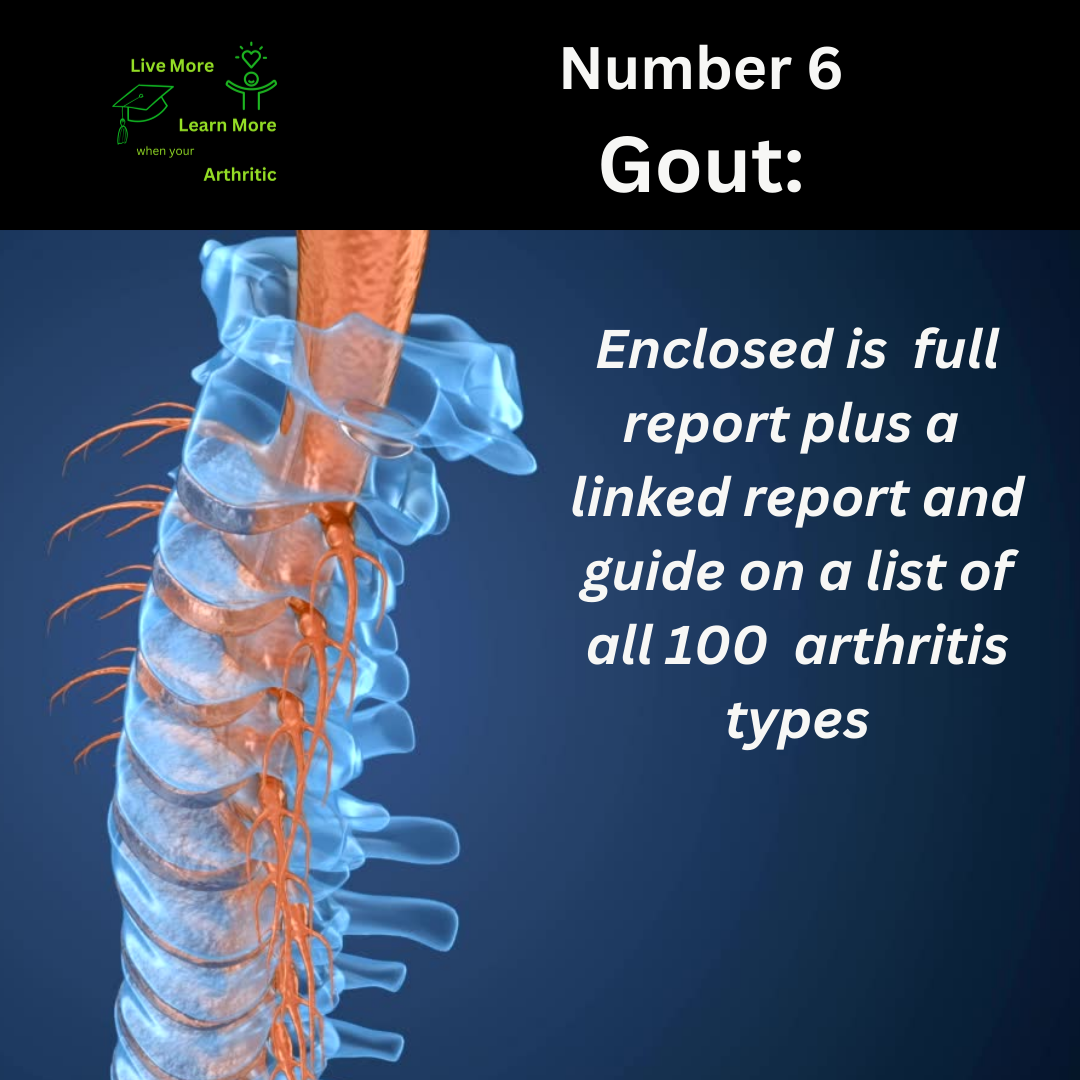
Gout: Number 6 on the list of 100 types of Arthritis
Conquering Gout: A Comprehensive Guide to Understanding and Managing Gout for a Better Quality of Life.
Gout is a complex and often misunderstood form of arthritis, characterized by sudden, severe attacks of pain, redness, and swelling in the joints. It primarily affects the joints at the base of the big toe, but can also occur in other joints like the ankles, knees, elbows, wrists, and fingers. Despite its challenges, with proactive management and a deep understanding of its causes and triggers, individuals can significantly improve their quality of life and even achieve remission.
Description: Gout is caused by the buildup of uric acid crystals in the joints and surrounding tissues. Uric acid is a waste product that normally dissolves in the blood and is excreted through the kidneys in urine. However, in some individuals, uric acid levels become too high due to either overproduction or insufficient excretion, leading to the formation of crystals.
Causes: Several factors contribute to the development of gout. Genetics play a role, as gout can run in families. Lifestyle factors such as diet (high intake of purine-rich foods like red meat, seafood, and alcohol), obesity, and certain medical conditions (e.g., high blood pressure, diabetes, kidney disease) can also increase the risk of developing gout.
Triggers: Gout attacks can be triggered by various factors, including:
- Dietary choices: Consuming foods high in purines.
- Alcohol consumption: Particularly beer and spirits.
- Dehydration: Insufficient fluid intake.
- Medications: Certain drugs like diuretics.
- Injury or surgery: Physical trauma can precipitate an attack.
Symptoms: The hallmark symptom of gout is intense pain, swelling, redness, and warmth in the affected joint. The pain can be debilitating, making movement difficult and leading to limited range of motion in the joint.
Achieving Remission and Improving Quality of Life
Achieving remission and improving quality of life with gout requires a multifaceted approach:
- Medication: Treatment often involves medications to reduce pain and inflammation during acute attacks (e.g., NSAIDs, corticosteroids) and long-term medications to lower uric acid levels (e.g., allopurinol, febuxostat).
- Lifestyle Changes: Adopting a healthy lifestyle can significantly impact gout management. This includes maintaining a balanced diet low in purines, staying hydrated, moderating alcohol intake, and achieving a healthy weight through regular exercise.
- Regular Monitoring: Monitoring uric acid levels and joint health through routine blood tests and check-ups can help prevent flare-ups and complications.
- Education and Support: Understanding the condition and its triggers empowers individuals to take control of their health. Support groups and healthcare providers can offer guidance and encouragement.
Complications and Breakthroughs
Complications: If left untreated or poorly managed, gout can lead to severe joint damage, chronic pain, and kidney stones due to uric acid crystal accumulation.
 New Science and Breakthroughs: Exciting advancements in gout research include the development of novel medications targeting specific pathways involved in uric acid metabolism, promising new imaging techniques for early detection of crystal deposits, and ongoing studies exploring the role of gut microbiota in gout pathogenesis.
New Science and Breakthroughs: Exciting advancements in gout research include the development of novel medications targeting specific pathways involved in uric acid metabolism, promising new imaging techniques for early detection of crystal deposits, and ongoing studies exploring the role of gut microbiota in gout pathogenesis.
Demographics and Impact
Gout primarily affects middle-aged and older adults, with the highest incidence between the ages of 40 and 60. Historically considered a disease of older men, gout is increasingly recognized in women, particularly post-menopause, due to hormonal changes.
Conclusion
In conclusion, while gout poses significant challenges, a proactive approach focusing on lifestyle modifications, regular monitoring, and advances in medical science can greatly enhance the quality of life for those living with this condition. By understanding the causes, triggers, and treatment options available, individuals can take charge of their health and strive for remission, allowing them to live life to the fullest despite gout’s presence.
